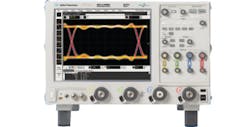Product Focus-Raising the B/W Bar to 32 GHz
Both the bandwidth and sample rate must be very high to have a truly fast scope. Silicon germanium (SiGe) has made possible the current generation of 15-GHz to 20-GHz bandwidth scopes. It’s interesting that some manufacturers have used DSP enhancement to glean a few more gigahertz, and yet another company has developed a bandwidth-doubling technique to achieve greater than 30 GHz. Nevertheless, further advances in SiGe amplifier performance most likely will only be incremental.
About three years ago, Agilent Technologies recognized this and began development of a new line of four-channel scopes based on indium phosphide (InP) semiconductors. The result is the 32-GHz Infiniium 90000 X-Series Oscilloscopes.
The standard memory length is 10 Mwords with optional extensions to 2 Gwords per channel. Bandwidth begins at 16 GHz with models at 20, 25, 28, and 32 GHz. The sample rate is 40 GHz per channel on all models, increasing to 80 GHz when channels are paired.
In four-channel mode, the scopes all have 16-GHz bandwidth. The higher bandwidths are available only in two-channel mode. A sampling stage is used ahead of the ADCs, and because of trade-offs made in the preamplifier/trigger/sampler hybrid, one sampler serves two channels. Either channel may have full bandwidth, but the sampler is limited to 32 GHz.
Beyond the high bandwidth, it’s the exceptional gain flatness and low noise associated with the InP-based amplifiers that really set this scope series apart. The amplifiers are inherently flat, which supports detailed specification of the scope’s frequency response in the datasheet. Noise is about half that of frequency-doubling scopes and significantly less than conventional SiGe scopes over their bandwidths. Especially noticeable at high data rates is the reduced jitter.
To accompany the 90000 X scopes, Agilent also developed the InfiniiMax III line of InP-based probes with 16-, 20-, 25-, and 30-GHz bandwidth. With integrated probe amplifier S-parameter correction, you get the full bandwidth at the probe tip, and the frequency response is guaranteed by AC calibration. Scope and probe bandwidths can be upgraded.
Probe use is facilitated by accessories including a browser tip; a solder-in probe head; a deskew fixture; a ZIF probe head; and adapters for a sampling scope, a high-impedance probe, and a 2.92-mm/SMA probe.
To complement the hardware, a full range of application-specific software enables de-embedding and equalization as well as support for emerging and proprietary standards. You can combine measurements and transmission line models to view simulated scope measurements at any location in your design. Equalization emulation can use your own tap values, or the 90000 X scope will find optimum values for you. And, when your FFE or CTLE process has been implemented, it works seamlessly with EZJIT or EZJIT+ software to perform jitter separation on the equalized waveform.
Scopes with this level of performance aren’t for everyone, nor are they inexpensive. Nevertheless, for those of you who need the accuracy that InP’s high bandwidth, low noise, and flat frequency response bring, the 90000 X-Series is what you’ve been waiting for.
DSO prices range from $146,000 for the 16-GHz Model 91604A to $266,000 for the 32-GHz Model 93204A. DSA model pricing starts at $146,000 and rises to $286,000 for similar scopes but includes serial data analysis, jitter software, and noise-reduction software plus 20-Mword memories as standard. Probe pricing starts at $14,400 for the N2800A 16-GHz model, increasing to $29,000 for the 30-GHz N2803A.
For More Information
Click Here
Published June, 2010

